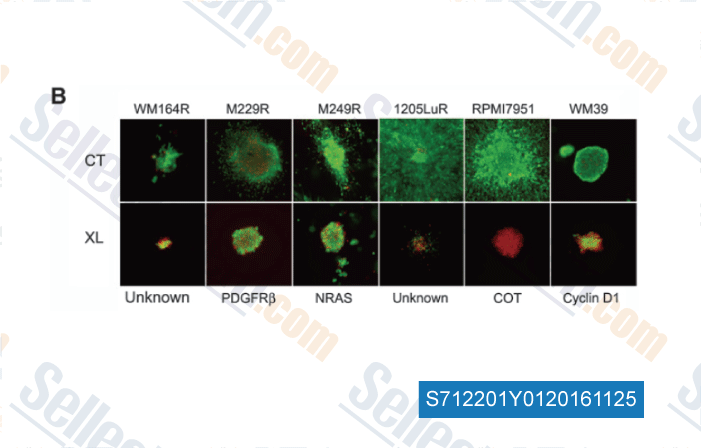|
Toll Free: (877) 796-6397 -- USA and Canada only -- |
Fax: +1-832-582-8590 Orders: +1-832-582-8158 |
Tech Support: +1-832-582-8158 Ext:3 Please provide your Order Number in the email. |
Technical Data
| Formula | C29H37N5O3 |
||||||
| Molecular Weight | 503.64 | CAS No. | 1149705-71-4 | ||||
| Solubility (25°C)* | In vitro | DMSO | 100 mg/mL (198.55 mM) | ||||
| Water | Insoluble | ||||||
| Ethanol | Insoluble | ||||||
| In vivo (Add solvents to the product individually and in order) |
|
||||||
|
* <1 mg/ml means slightly soluble or insoluble. * Please note that Selleck tests the solubility of all compounds in-house, and the actual solubility may differ slightly from published values. This is normal and is due to slight batch-to-batch variations. * Room temperature shipping (Stability testing shows this product can be shipped without any cooling measures.) |
|||||||
Preparing Stock Solutions
Biological Activity
| Description | XL888 is an ATP-competitive inhibitor of HSP90 with IC50 of 24 nM. Phase 1. | ||
|---|---|---|---|
| Targets |
|
||
| In vitro | XL888 induces HER2 degradation in NCI-N87 cells with IC50 of 56 nM. XL888 inhibits the proliferation of HER2 over-expressed NCI-N87, HER2 over-expressed BT-474, HER2 over-expressed MDA-MB-453, MET mutated MKN45, B-Raf mutated Colo-205, B-Raf mutated SK-MEL-28, EGFR mutated HN5, EGFR mutated NCI-H1975, PI3K mutated MCF7, and K-Ras mutated A549 with IC50 of 21.8, 0.1, 16.0, 45.5, 11.6, 0.3, 5.5, 0.7, 4.1 and 4.3 nM. [1] XL888 leads to dose-dependent decreases in the growth of vemurafenib-naive and vemurafenib-resistant melanoma cell lines and melanoma cell lines with intrinsic resistance with IC50 of all around 0.1 μM. The growth inhibitory effects of XL888 are associated with induction of either a G1-phase cell-cycle arrest (WM164, M229, M229R, M249, M249R, 1205Lu, and WM39 cell lines) or a G2-M phase cell-cycle arrest (WM164R, 1205LuR, and RPMI 7951 cell lines). XL888 (300 nmol) induces high levels ( > 66%) of apoptosis, and loss of mitochondrial membrane potential (TMRM) in these cell lines. The cytotoxic effects of XL888 are durable with no signs of colony formation observed in any of the cell lines even cultured up to 4 weeks. XL888 treatment (300 nM, 48 hours) leads to the degradation of IGF1R, PDGFRβ, ARAF, CRAF, and cyclin D1 and the inhibition of AKT, ERK, and S6 signaling in all of the cell lines with acquired BRAF inhibitor resistance. treatment of cell lines that are naive, intrinsically resistant, and with acquired vemurafenib resistance. Treatment with XL888 (300 nM) leads to robust time-dependent increases in the expression of HSP70 isoform 1. XL888 (48 hours, 300 nM) treatment increases the expression of BIM-EL, BIM-L, and BIM-S expression in the M229R, 1205LuR, RPMI7951, and WM39 cell lines, induces expression of BIM-L and BIM-S in the WM164R cell line, and BIM-EL in the M249R cell line. [2] | ||
| In vivo | XL888 (100 mg/kg) significantly induces the regression of, or growth inhibition (50%) of established M229R and 1205LuR xenografts in SCID mice. 15 days of XL888 treatment showes a robust (8.6-fold) increase in intratumoral HSP70 expression compared with controls. XL888 treatment is noted to be proapoptotic in vivo and leads to increased TUNEL staining in M229R xenografts associated with increased expression of BIM and decreased expression of Mcl-1. [2] |
Protocol (from reference)
| Cell Assay:[2] |
|
|---|---|
| Animal Study:[2] |
|
References
|
Customer Product Validation

-
Data from [Data independently produced by , , Clin Cancer Res, 2012, 18(9):2502-2514.]
Selleck's XL888 has been cited by 5 publications
| BRAFΔβ3-αC in-frame deletion mutants differ in their dimerization propensity, HSP90 dependence, and druggability [ Sci Adv, 2023, 9(35):eade7486] | PubMed: 37656784 |
| deepOrganoid: A brightfield cell viability model for screening matrix-embedded organoids [ SLAS Discov, 2022, 27(3):175-184] | PubMed: 35314378 |
| In Vivo Conformational Dynamics of Hsp90 and Its Interactors [ Cell Chem Biol, 2016, 23(6):716-26] | PubMed: 27341434 |
| Reactivation of ERK and Akt confers resistance of mutant BRAF colon cancer cells to the HSP90 inhibitor AUY922. [ Oncotarget, 2016, 7(31):49597-49610] | PubMed: 27391062 |
| The HSP90 inhibitor XL888 overcomes BRAF inhibitor resistance mediated through diverse mechanisms. [Paraiso KH, et al. Clin Cancer Res, 2012, 18(9):2502-14] | PubMed: 22351686 |
RETURN POLICY
Selleck Chemical’s Unconditional Return Policy ensures a smooth online shopping experience for our customers. If you are in any way unsatisfied with your purchase, you may return any item(s) within 7 days of receiving it. In the event of product quality issues, either protocol related or product related problems, you may return any item(s) within 365 days from the original purchase date. Please follow the instructions below when returning products.
SHIPPING AND STORAGE
Selleck products are transported at room temperature. If you receive the product at room temperature, please rest assured, the Selleck Quality Inspection Department has conducted experiments to verify that the normal temperature placement of one month will not affect the biological activity of powder products. After collecting, please store the product according to the requirements described in the datasheet. Most Selleck products are stable under the recommended conditions.
NOT FOR HUMAN, VETERINARY DIAGNOSTIC OR THERAPEUTIC USE.
